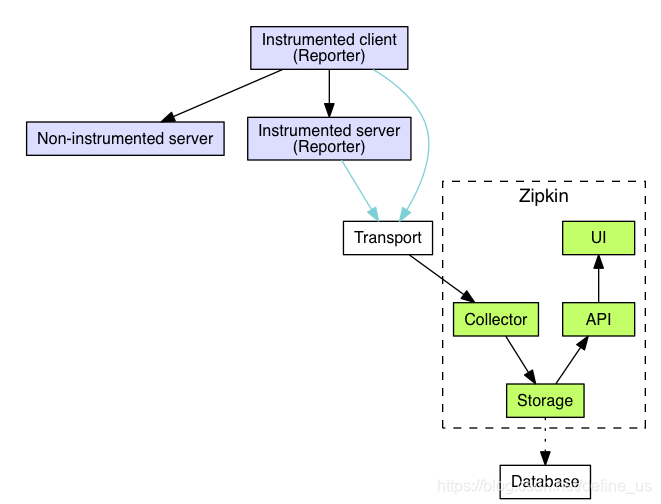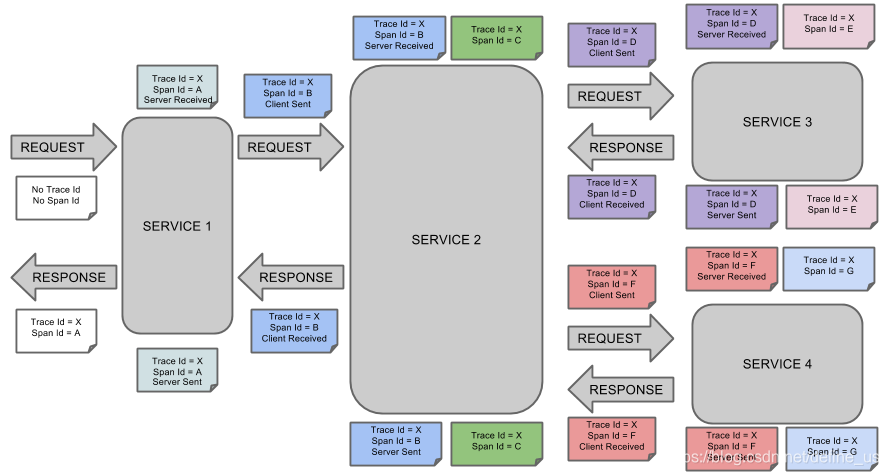其实链路追踪远不止twiter的zipkin,还有如下方案Uber的Jaeger,阿里的鹰眼,美团的Mtrace等都基本被启发于google发表的Dapper
Zipkin的原理如下

zipkin作为日志收集系统,有几种默认的传输数据方式,常用Http传输,但是在业务量较大的时候,频繁的Http请求不再满足需求,因此引入kafka作为传输数据的方式。
Zipkin Server在启动时指定使用elasticsearch作为追踪日志存储。
下面是一次调用的流程。
┌─────────────┐ ┌───────────────────────┐ ┌─────────────┐ ┌──────────────────┐
│ User Code │ │ Trace Instrumentation │ │ Http Client │ │ Zipkin Collector │
└─────────────┘ └───────────────────────┘ └─────────────┘ └──────────────────┘
│ │ │ │
┌─────────┐
│ ──┤GET /foo ├─▶ │ ────┐ │ │
└─────────┘ │ record tags
│ │ ◀───┘ │ │
────┐
│ │ │ add trace headers │ │
◀───┘
│ │ ────┐ │ │
│ record timestamp
│ │ ◀───┘ │ │
┌─────────────────┐
│ │ ──┤GET /foo ├─▶ │ │
│X-B3-TraceId: aa │ ────┐
│ │ │X-B3-SpanId: 6b │ │ │ │
└─────────────────┘ │ invoke
│ │ │ │ request │
│
│ │ │ │ │
┌────────┐ ◀───┘
│ │ ◀─────┤200 OK ├─────── │ │
────┐ └────────┘
│ │ │ record duration │ │
┌────────┐ ◀───┘
│ ◀──┤200 OK ├── │ │ │
└────────┘ ┌────────────────────────────────┐
│ │ ──┤ asynchronously report span ├────▶ │
│ │
│{ │
│ "traceId": "aa", │
│ "id": "6b", │
│ "name": "get", │
│ "timestamp": 1483945573944000,│
│ "duration": 386000, │
│ "annotations": [ │
│--snip-- │
└────────────────────────────────┘
目前Zipkin支持的主流架构如下

一些概念
- Trace
Zipkin使用Trace结构表示对一次请求的跟踪,一次请求可能由后台的若干服务负责处理,每个服务的处理是一个Span,Span之间有依赖关系,Trace就是树结构的Span集合; - Span
每个服务的处理跟踪是一个Span,可以理解为一个基本的工作单元,包含了一些描述信息:id,parentId,name,timestamp,duration,annotations等,例如:
{
"traceId": "bd7a977555f6b982",
"name": "get-traces",
"id": "ebf33e1a81dc6f71",
"parentId": "bd7a977555f6b982",
"timestamp": 1458702548478000,
"duration": 354374,
"annotations": [
{
"endpoint": {
"serviceName": "zipkin-query",
"ipv4": "192.168.1.2",
"port": 9411
},
"timestamp": 1458702548786000,
"value": "cs"
}
],
"binaryAnnotations": [
{
"key": "lc",
"value": "JDBCSpanStore",
"endpoint": {
"serviceName": "zipkin-query",
"ipv4": "192.168.1.2",
"port": 9411
}
}
]
}
traceId:标记一次请求的跟踪,相关的Spans都有相同的traceId;
id:span id;
name:span的名称,一般是接口方法的名称;
parentId:可选的id,当前Span的父Span id,通过parentId来保证Span之间的依赖关系,如果没有parentId,表示当前Span为根Span;
timestamp:Span创建时的时间戳,使用的单位是微秒(而不是毫秒),所有时间戳都有错误,包括主机之间的时钟偏差以及时间服务重新设置时钟的可能性,
出于这个原因,Span应尽可能记录其duration;
duration:持续时间使用的单位是微秒(而不是毫秒);
annotations:注释用于及时记录事件;有一组核心注释用于定义RPC请求的开始和结束;
cs:Client Send,客户端发起请求;
sr:Server Receive,服务器接受请求,开始处理;
ss:Server Send,服务器完成处理,给客户端应答;
cr:Client Receive,客户端接受应答从服务器;
binaryAnnotations,二进制注释,旨在提供有关RPC的额外信息。





















 161
161

 被折叠的 条评论
为什么被折叠?
被折叠的 条评论
为什么被折叠?








